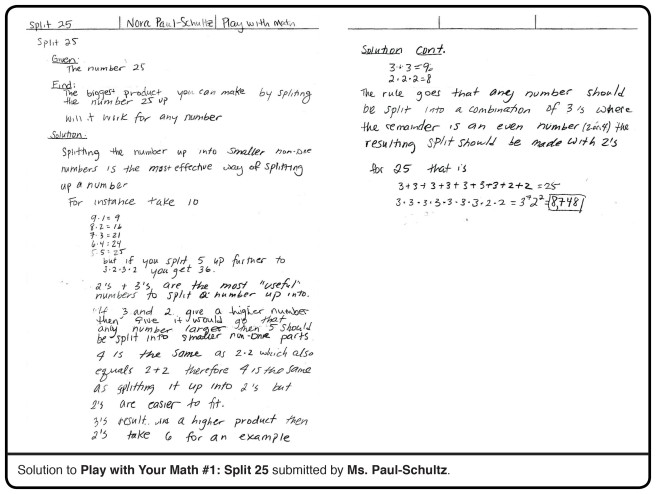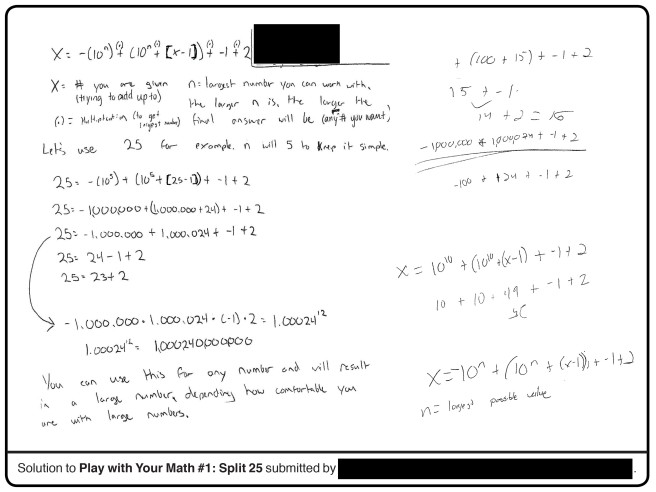 The problem that started it all! This problem was a huge hit with our students, and we actually got enough submissions to sort through them, determine the winners, and post their solutions for all to marvel at.
The problem that started it all! This problem was a huge hit with our students, and we actually got enough submissions to sort through them, determine the winners, and post their solutions for all to marvel at.
Important note: I suggest that you stop here and try the problem if you haven’t already. The solutions below could be considered spoilers.
Highlight #1: Participation
The scope of participation on this problem was truly incredible. I tried it out with all of my classes, most of my students were engaged, and a few were hooked. But that’s not all. Somehow, the problem ended up in an all-staff email and on the school website. We had participation from students who didn’t have any of the teachers involved in making it. A handful of non-math teachers approached me to ask about their progress, plus a couple of administrators. Our physics teacher provided one of our winning solutions. She maintains that she could have done better, but the math teachers spoiled it for her.
Highlight #2: Variety of Solutions
I love how this problem is open for interpretation. What is a piece? Does it have to be a natural number? Can it be negative? Can it be a fraction/decimal? Can it be irrational? Each interpretation has its own best answer, and our students found just about all of them. Our second winner was a group of students who realized you can make the number infinitely big if you allow negative numbers. I was really impressed by their explanation and their attempt to generalize, especially since these students have probably never made this type of analysis before.
Highlight #3: Learning new math.
One of my honors precalculus students – and our final winner – took this problem to its most interesting conclusion: e. The number of steps he took to reach this solution is really impressive: he found the maximum with natural numbers, realized he could use negative numbers, concluded that wasn’t all that interesting, realized he could use rational numbers, created a formula, challenged his formula, drew a graph, analyzed his graph, made a conjecture, improved his formula, and even indicated the domain to which it applied. If I could only get him to put this much effort into his homework …
Highlight #4: Intellectual Vindication
As we were waiting for student solutions, we saw this problem was in the March 2014 edition of The Mathematics Teacher, in “A Rationale for Irrationals: An Unintended Exploration of e.” An interesting title for this problem, considering many students did great mathematical thinking and only one found his way to e, but clearly we were not the only teachers to love this problem.
Room for Improvement: Many students tried the problem for a little while, settled on an answer, checked with someone else, realized they could do better, didn’t immediately see how, and stopped. We have work to do when it comes to mathematical perseverance.

I spoke to Wasserman (at Teachers College) about this article shortly after he published it; Henry Pollak, also at TC, noted that the proof of ‘e’ being optimal does not require Calculus, and can be done with the AM-GM inequality instead. Subsequently, I located the problem as broached in an exploratory manner in an earlier article: Krause, E. F. (1996). Maximizing the product of summands; minimizing the sum of factors. Mathematics Magazine, 270-278. Retrieved from http://www.jstor.org/stable/2690532. (Krause provides solutions using both of the aforementioned methods.)
LikeLike
Well that certainly explains how you knew the answer so quickly. It might take me a while to understand those solutions, but I’m still not sure if they explain how or why to talk about e in a non-calculus class.
LikeLike